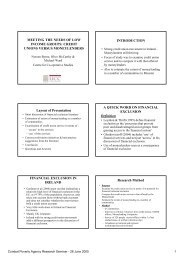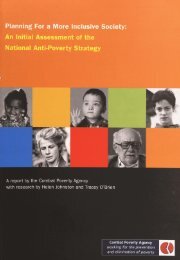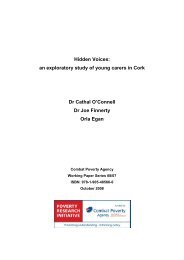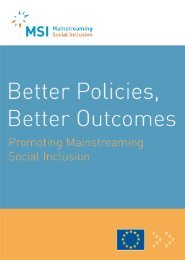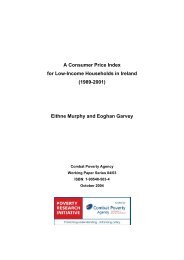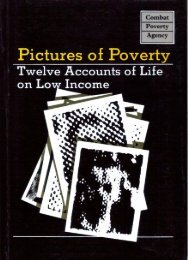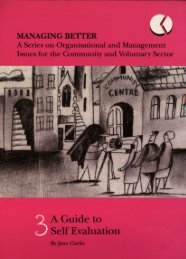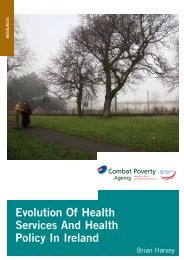The Distribution of Income in Ireland (2000) - Combat Poverty Agency
The Distribution of Income in Ireland (2000) - Combat Poverty Agency
The Distribution of Income in Ireland (2000) - Combat Poverty Agency
- No tags were found...
Create successful ePaper yourself
Turn your PDF publications into a flip-book with our unique Google optimized e-Paper software.
2 <strong>The</strong> <strong>Distribution</strong> <strong>of</strong> <strong>Income</strong> <strong>in</strong> <strong>Ireland</strong><strong>The</strong> study is structured as follows. Chapter 2 describes thesurvey data on which the study relies and how <strong>in</strong>come and itsdistribution are measured. Chapter 3 exam<strong>in</strong>es the distribution<strong>of</strong> household <strong>in</strong>come <strong>in</strong> <strong>Ireland</strong> <strong>in</strong> the 1990s. Chapter 4 makesuse <strong>of</strong> data from earlier surveys to analyse how the distribution<strong>of</strong> <strong>in</strong>come <strong>in</strong> <strong>Ireland</strong> changed between 1987 and 1994, and alsoto exam<strong>in</strong>e longer-term trends <strong>in</strong> the <strong>in</strong>come distribution backto 1973. Chapter 5 focuses on how the level <strong>of</strong> <strong>in</strong>equality <strong>in</strong> thedistribution <strong>of</strong> household <strong>in</strong>come <strong>in</strong> <strong>Ireland</strong> compares withother countries. Chapter 6 turns to the distribution <strong>of</strong> earn<strong>in</strong>gs,the most important source <strong>of</strong> <strong>in</strong>come, and how this evolved <strong>in</strong><strong>Ireland</strong> over the decade from 1987. Chapter 7 then looks at therelationship between the earn<strong>in</strong>gs distribution and the overalldistribution <strong>of</strong> <strong>in</strong>come among households, focus<strong>in</strong>g <strong>in</strong> particularon the way <strong>in</strong> which the earn<strong>in</strong>gs <strong>of</strong> husbands and their wivesare related, and how that <strong>in</strong>fluences the household <strong>in</strong>come distribution.F<strong>in</strong>ally, Chapter 8 br<strong>in</strong>gs together the ma<strong>in</strong> f<strong>in</strong>d<strong>in</strong>gs.Chapter 2Measur<strong>in</strong>g the <strong>Distribution</strong> <strong>of</strong><strong>Income</strong> <strong>in</strong> <strong>Ireland</strong>Brian Nolan2.1 INTRODUCTIONBefore one can exam<strong>in</strong>e empirical evidence about the distribution<strong>of</strong> <strong>in</strong>come, it is essential to have an understand<strong>in</strong>g <strong>of</strong> theway <strong>in</strong>comes, their distribution, and the extent <strong>of</strong> <strong>in</strong>equality aremeasured. <strong>The</strong> aim <strong>of</strong> this chapter is to describe the data onwhich this study relies, and outl<strong>in</strong>e how <strong>in</strong>come and its distributionare to be measured. Section 2.2 focuses on the description<strong>of</strong> the household surveys to be employed and the <strong>in</strong>formationthey obta<strong>in</strong> on <strong>in</strong>come. Section 2.3 outl<strong>in</strong>es methodologicalissues which arise <strong>in</strong> measur<strong>in</strong>g the distribution <strong>of</strong> <strong>in</strong>come andthe extent <strong>of</strong> <strong>in</strong>come <strong>in</strong>equality, and the approaches to beadopted <strong>in</strong> this study.2.2 MEASURING THE DISTRIBUTION OF INCOME: DATA ANDPREVIOUS RESEARCHStudies <strong>of</strong> the distribution <strong>of</strong> <strong>in</strong>come <strong>in</strong> <strong>Ireland</strong> rely on householdsurveys rather than adm<strong>in</strong>istrative tax/social security recordsto provide the database. (See Nolan, 1978 for a discussion<strong>of</strong> the use <strong>of</strong> survey versus adm<strong>in</strong>istrative data on <strong>in</strong>come distribution<strong>in</strong> the Irish case, and Callan, 1991a, for a discussion <strong>of</strong>survey and Revenue Commissioners <strong>in</strong>come data). In this studywe rely on data from two sets <strong>of</strong> large-scale household surveys.<strong>The</strong> first comprises the survey carried out by the ESRI <strong>in</strong> 1987,




